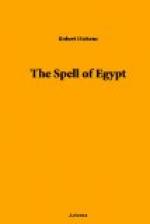Here lay the Osirians, those blessed dead of the land of Egypt, who worshipped the Judge of the Dead, the Lord of the Underworld, and who hoped for immortality through him—Osiris, husband of Isis, Osiris, receiver of prayers. Osiris the sun who will not be conquered by night, but eternally rises again, and so is the symbol of the resurrection of the soul. It is said that Set, the power of Evil, tore the body of Osiris into fourteen fragments and scattered them over the land. But multitudes of worshippers of Osiris believed him buried near Abydos and, like those who loved the sweet songs of Hafiz, they desired to be buried near him whom they adored; and so this place became a place of the dead, a place of many prayers, a white place of many longings.
I was glad to be alone there. The guardian left me in perfect peace. I happily forgot him. I sat down in the shadow of a column upon its mighty projecting base. The sky was blinding blue. Great bees hummed, like bourdons, through the silence, deepening the almost heavy calm. These columns, architraves, doorways, how mighty, how grandly strong they were! And yet soon I began to be aware that even here, where surely one should read only the Book of the Dead, or bend down to the hot ground to listen if perchance one might hear the dead themselves murmuring over the chapters of Beatification far down in their hidden tombs, there was a likeness, a gentle gaiety of life, as in the tomb of Thi. The effect of solidity was immense. These columns bulged, almost like great fruits swollen out by their heady strength of blood. They towered up in crowds. The heavy roof, broken in places most mercifully to show squares and oblongs of that perfect, calling blue, was like a frowning brow. And yet I was with grace, with gentleness, with lightness, because in the place of the dead I was again with the happy, living walls. Above me, on the roof, there was a gleam of palest blue, like the blue I have sometimes seen at morning on the Ionian sea just where it meets the shore. The double rows of gigantic columns stretched away, tall almost as forest trees, to right of me and to left, and were shut in by massive walls, strong as the walls of a fortress. And on these columns, and on these walls, dead painters and gravers had breathed the sweet breath of life. Here in the sun, for me alone, as it seemed, a population followed their occupations. Men walked, and kneeled, and stood, some white and clothed, some nude, some red as the red man’s child that leaped beyond the sea. And here was the lotus-flower held in reverent hands, not the rose-lotus, but the blossom that typified the rising again of the sun, and that, worn as an amulet, signified the gift of eternal youth. And here was hawk-faced Horus, and here a priest offering sacrifice to a god, belief in whom has long since passed away. A king revealed himself to me, adoring Ptah, “Father of the beginnings,” who established upon earth, my figures thought, the everlasting justice, and again at the knees of Amen burning incense in his honor. Isis and Osiris stood together, and sacrifice was made before their sacred bark. And Seti worshipped them, and Seshta, goddess of learning, wrote in the book of eternity the name of the king.




